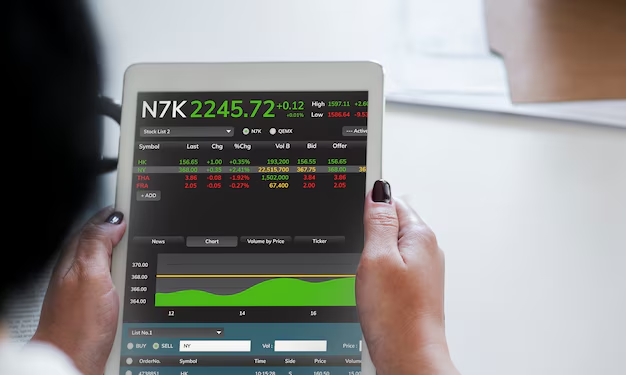How do you calculate the RSI? This question is critical because the RSI (Relative Strength Index) helps traders determine if a currency pair is overbought or oversold.
And, if you are serious about forex trading, you have probably heard traders talk about RSI.
Understanding RSI can give you a strong advantage in the forex market, and in this guide, we will explain everything to you in the simplest way possible.
You are about to learn the step-by-step method to calculate RSI, see real-life examples, and understand the pros and cons of using it in forex trading.
Keep reading because this information can help you make better trading decisions.
In This Post
What Is the Relative Strength Index (RSI)?
RSI (Relative Strength Index) is a momentum indicator used in technical analysis to measure the speed and change of price movements.
It helps traders know if a currency pair is overbought or oversold, which can indicate a potential price reversal.
The RSI moves between 0 and 100. Typically, an RSI above 70 means an asset is overbought, while an RSI below 30 means it is oversold.
Traders use RSI to predict price movements and find good trading opportunities.
Step-by-Step Guide to Calculating RSI
The RSI (Relative Strength Index) is a momentum indicator used in trading to measure the strength of price movements.
It ranges from 0 to 100 and helps traders identify overbought and oversold conditions.
The default RSI period is 14, but it can be adjusted depending on the trading strategy.
To calculate the RSI, follow these steps:
RSI Formula
RSI = 100 – (1+RS) / 100
Where:
- RS (Relative Strength) = Average Gain / Average Loss
Step 1: Collect Price Data
Choose a period (default = 14 periods) and gather the closing prices.
Step 2: Calculate Price Changes
Find the price change for each period:
Price Change = Current Close – Previous Close
If the price increases, it’s a gain.
If the price decreases, it’s a loss.
Step 3: Calculate Average Gain and Average Loss
For the first RSI calculation (using 14 periods)
Average Gain = ∑Gains over 14 periods / 14
Average Loss = ∑Losses over 14 periods / 14
This means:
Add up all the gains from the last 14 periods and divide by 14 to get the Average Gain.
Add up all the losses from the last 14 periods and divide by 14 to get the Average Loss.
For subsequent RSI calculations (smoothing method):
Average Gain = (Previous Average Gain x 13 + Current Gain) / 14
Average Loss = (Previous Average Loss x 13 + Current Loss) / 14
Step 4: Calculate Relative Strength (RS)
RS = Average Gain / Average Loss
Step 5: Calculate RSI Value
RSI = 100 – 100 / 1 + RS
Example RSI Calculation (14-Period RSI)
Assume we have the following price changes over 14 days:
Price Changes Over 14 Days
Gains: 0.5, 1.2, 0.8, 1.5, 0.4, 0.6, 1.1
Losses: -0.3, -0.7, -0.5, -0.9, -0.4, -1.0, -0.6
Step 1: Calculate Averages
The sum of gains
0.5 + 1.2 + 0.8 + 1.5 + 0.4 + 0.6 +1.1 = 6.1
Sum of losses
0.3 + 0.7 + 0.5 + 0.9 + 0.4 + 1.0 + 0.6 = 4.4
Compute Average Gain and Average Loss
Average Gain = 6.1 / 14 = 0.44
Average Loss = 4.4 / 14 = 0.31
This means
- Add up all the gains from the last 14 periods and divide by 14 to get the Average Gain.
- Add up all the losses from the last 14 periods and divide by 14 to get the Average Loss.
Step 2: Compute Relative Strength (RS)
RS = 0.44 / 0.31 = 1.42
Step 3: Compute RSI
- RSI = 100 – ( 1+1.42 ) / 100
- RSI = 100 – ( 2.42 ) / 100
- RSI = 100 – 41.32
- RSI = 58.68
This means the RSI value is 58.68, indicating a neutral-to-bullish trend.
Example of RSI Calculation
Let’s say you are tracking a forex pair over 14 days:
The price increased in 8 days, with a total gain of 40 pips. The Average Gain is:
40 pips ÷ 14 = 2.86 pips
The price decreased in 6 days, with a total loss of 20 pips. The Average Loss is:
20 pips ÷ 14 = 1.43 pips
Now, calculate the Relative Strength (RS):
RS = Average Gain ÷ Average Loss
RS = 2.86 ÷ 1.43 = 2
Finally, calculate the RSI using the RSI formula:
RSI = 100 – (100) / 1+RS
The RSI = 100 – (100) / 1+2
RSI = 100 – (100) / 3
RSI = 100 – 33.33 = 66.67
In this case, the RSI is 66.67, which means the forex pair is approaching overbought levels but has not yet reached 70, where traders usually expect a possible price reversal.
RSI Trading Interpretation
- RSI > 70 = Overbought (Possible Sell Signal)
- RSI < 30 = Oversold (Possible Buy Signal)
- RSI ~50 = Neutral/Trend Confirmation
Since the manual calculation is time-consuming, traders usually use trading platforms (MT4, TradingView, etc.) to calculate RSI automatically.
Pros of Using RSI in Forex Trading
1. Easy to Use
The Relative Strength Index (RSI) is one of the easiest technical indicators to understand and apply. Its formula is simple, and even beginner traders can use it without much difficulty.
Unlike complex indicators that require advanced calculations, RSI provides clear overbought and oversold signals, making it a favorite among traders.
2. Helps Identify Overbought and Oversold Conditions
RSI is excellent for spotting potential trend reversals. When the RSI moves above 70, it suggests that a currency pair may be overbought, meaning a price drop could be expected.
When the RSI falls below 30, it indicates an oversold condition, signaling a possible price increase. Traders use these levels to time their entries and exits more effectively.
3. Works with Other Indicators
The RSI becomes even more powerful when combined with other technical indicators such as Moving Averages, MACD, and Bollinger Bands.
For example, if the RSI shows an oversold condition and a Moving Average crossover confirms an upward trend, traders can feel more confident about entering a long position.
4. Helps Avoid Emotional Trading
Instead of making impulsive and emotionally driven trading decisions, RSI provides clear buy and sell signals.
By relying on RSI readings rather than gut feelings, traders can follow a structured trading plan, reducing the risk of making costly mistakes due to panic or greed.
Cons of Using RSI in Forex Trading
1. False Signals
One of the biggest drawbacks of RSI is that it can generate false signals. Sometimes, the RSI may indicate that a currency pair is overbought or oversold, but the price keeps moving in the same direction.
This can lead traders to enter trades too early, resulting in losses. To minimize this risk, RSI should always be used with additional indicators for confirmation.
2. Less Effective in Strong Trends
In strong upward or downward trends, RSI can remain in overbought or oversold territory for an extended period.
For example, in a bullish market, the RSI may stay above 70 for a long time, leading traders to mistakenly exit trades too soon.
This is why it’s important to analyze the overall market trend before making trading decisions solely based on RSI signals.
3. Requires Confirmation
RSI should never be used alone for trading decisions. Always confirm RSI signals with other technical indicators, such as MACD crossovers, trend lines, or support and resistance levels.
A strong confirmation strategy can help traders avoid unnecessary risks and improve the accuracy of their trades.
Frequently Asked Questions
Can RSI be used alone for trading?
- No, RSI should be used alongside other indicators like moving averages and trend lines for better accuracy.
What is the best RSI setting for forex trading?
- The default setting is 14 periods, but some traders use 9 or 21 depending on their strategy.
Is RSI better for long-term or short-term trading?
- RSI works well for both, but short-term traders (scalpers and day traders) may adjust the settings for faster signals.
How do I know if RSI is giving a false signal?
- If RSI shows an overbought or oversold condition but there is no price reversal, it might be a false signal. Confirm with other indicators before making a decision.
Conclusion
RSI is one of the most important tools in forex trading when used correctly. It helps traders find entry and exit points based on momentum.
Now that you understand how to calculate RSI, you can start applying it to your trades.
However, never rely on RSI alone. Always use it with other indicators to increase accuracy and avoid false signals.
Forex trading is about making informed decisions, and RSI is just one of the many tools to help you succeed.




